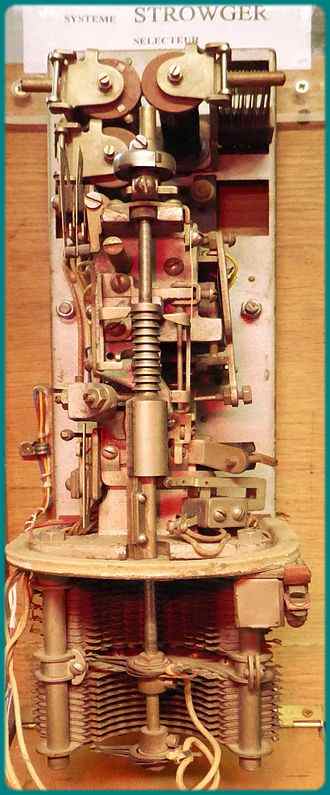|
Why the Automatic Telephone Exchange Was Invented From the very beginning of the telephone era, manual switchboards originally invented by the Hungarian engineer Tivadar
PUSK┴S, were used in telephone exchanges.
Later on as I know, these switchboards had grown as large as to
serve about 60,000 subscribers. They were simple to use, worked fine
with the help of many operators. However,
after a time Mr. Strowger noticed that his business had
declined. What happened? Less people were about to die or, somebody
invented the elixir
for eternal life? Nonsense. Soon he understood that it was the competitor's wife who, as an operator in the phone exchange, directed the calls „automatically” to his husband when funeral calls came in. (Early
time automation meant a manual exchange.)
Even more, when the operator learned an armed conflict has
unfolded somewhere in the town, she immediately warned her husband to
hurry with collecting the victims' bodies. According to other sources, when Strowger’s friend had died, the body
was taken by his competitor due to a similarly diverted phone call. Finally, Mr. Strowger became so angry that he started elaborate a
method to exclude swindler operators from phone calls. As was known, the
basic idea was his own, but he also searched for supporters and engineers
so that in the end he invented the first automatic telephone switch, named after him. He applied for a U.S. patent in 1889, which was issued in 1891. The Strowger Switch is a simple and logical device. In the middle of the device there is an
axis (a rod) that can be lifted and rotated by steps. An arm
fixed to this axis holds a metal brush (moving contact)
for
making
electrical contacts. Around the axis there is a semicircle block
containing 100
fixed contacts, arranged in 10 levels ("storeys") with 10 contacts in
each level. Each contact corresponds to a subscriber’s phone. The
metal brush is first
lifted to the level needed, than it rotates to the selected
contact there for
connecting the
adequate subscriber’s line. Lifting and rotating the metal brush
are performed by
relay-like
electromagnets and ratchet mechanics where every electric pulse will
cause one
step. That's why it
is called a step-by-step device. Since one
telephone
connection requires two lines, either the construct itself was
doubled with a common axis or, double
contacts
were applied. After a call had ended, the switch/metal brush moved back
to its initial
state. In practice, one switch established only one call at a time so simultaneous calls demanded several switches. The
first telephones in this system were provided with push-buttons;
e.g. if someone was about to give in number 9, the button had to
be pushed 9 times. Sure, it was
cumbersome in practice. If the number of subscribers exceeded 100, similar switches were to
be used for further group selectors for hundreds, thousands etc. of lines, up
to some ten thousand lines. In other words, this system was „scalable”. Later,
when developing the system, very
complicated set of relays i.e. sequence switches etc. were added.
However, the Strowger switch itself remained essential. (The complete description of an automatic telephone exchange in operation, even
if very exciting, is far beyond the scope of this paper.) Strowger and his backers formed a company, first Strowger
Automatic Telephone Exchange Company, later the Automatic Electric Company to
transfer the patent into everyday use. The company installed and opened the first commercial telephone exchange in La Porte, Indiana on November 3, 1892, with
about 75 subscribers and a capacity for 99. Under the technical
leadership of Alexander E. Keith, Automatic Electric Company produced a steady series
of significant advances yielding a commercially viable system.
Most notable of the advances was the invention of the phone dial in 1896.
Just to understand: dialing number 0 gives 10 pulses as zero pulse will
cause no effects. About 1900, the Strowger
system set off in the U.S. and about 1910 in Europe, too. Strowger himself seemed not to
have taken part in further developments. He had left the company, also
selling his patent and shares. His patents were sold to Bell
Systems for $2.5 million, in 1916. But Strowger’s name is forever intertwined with automated telephone systems. In 1965, Strowger was admitted to the
hall of fame of the U.S. Independent Telephone Association (today the USTA). The stepping movement of the
Strowger switch caused significant wear of the ratchets and inaccuracy in
finding the contacts. In spite of its inherent disadvantages, by the 1960s, the Strowger exchanges
were in widespread use. Later on, other, more
sophisticated switches and systems emerged for use in telephone exchanges. Rotary switch: it is similar to
the Strowger switch but with no level shifting. The rotational movement of the
brushes (driven from a continuously rotating axis + disk) is controlled by an
electromagnetic combined clutch-brake pad.
The cross-bar switch has a
very different topology, enabling bypass routes. The basic switch is a matrix
of ten by ten perpendicular contact rods, ten inputs and ten outputs, with
relay-like movement that establishes contact from any input to any output,
one contact at a time. The mechanical movement of the switch is very tiny
therefore it is very reliable. It’s widespread use was realized by the availability of
the system's computer control.  Technology background: US Patent No 447,918 / Mar. 10, 1891
-
GL -
The author is a qualified electrical engineer with experience in industrial R&D and higher education. |
